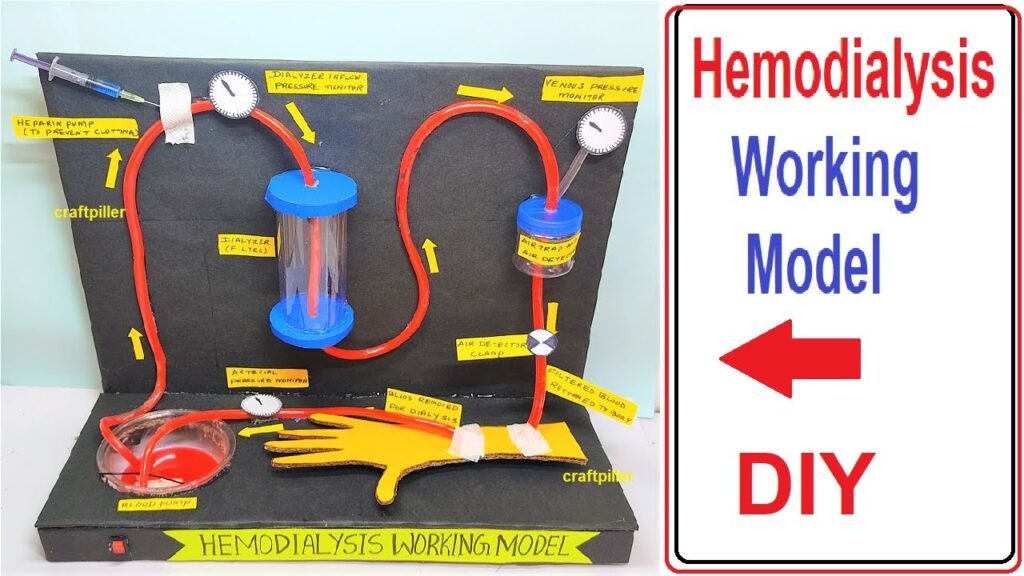1. What is hemodialysis?
- Answer: Hemodialysis is a medical procedure used to filter and remove waste products and excess fluids from the blood when the kidneys are unable to perform these functions adequately.

2. Why is hemodialysis necessary?
- Answer: Hemodialysis is necessary when kidneys fail to effectively filter waste and excess fluids, leading to a buildup of toxins in the bloodstream.
3. What is the role of an artificial kidney in hemodialysis?
- Answer: An artificial kidney mimics the function of natural kidneys by removing waste and excess fluids from the blood during hemodialysis.
4. How does an artificial kidney work?
- Answer: An artificial kidney uses a dialysis membrane to filter blood. It allows waste products and excess fluids to pass from the blood into a solution called dialysate.
5. What is the dialysate in hemodialysis?
- Answer: Dialysate is a solution that helps remove waste products and excess fluids during hemodialysis. It flows on one side of the dialysis membrane, allowing for the exchange of substances with the blood.
6. How often is hemodialysis typically performed?
- Answer: Hemodialysis is usually performed three times a week, with each session lasting around 3 to 4 hours.
7. What are the common conditions that necessitate hemodialysis?
- Answer: Conditions such as chronic kidney disease, end-stage renal disease (ESRD), and acute kidney injury may require hemodialysis.
8. What are the potential complications of hemodialysis?
- Answer: Complications can include low blood pressure, muscle cramps, infections, and long-term issues related to vascular access.
9. What is vascular access in hemodialysis?
- Answer: Vascular access is the way blood is removed and returned during hemodialysis. It can be achieved through an arteriovenous fistula, arteriovenous graft, or a central venous catheter.
10. How does an arteriovenous fistula work in hemodialysis?
Answer: An arteriovenous fistula is a surgical connection between an artery and a vein. It creates a high-flow access point for blood to be withdrawn and returned during hemodialysis.
11. What is the purpose of anticoagulants during hemodialysis?
Answer: Anticoagulants are used during hemodialysis to prevent blood clotting within the dialysis machine and tubing.
12. How is fluid removal controlled during hemodialysis?
Answer: Fluid removal is controlled by adjusting the ultrafiltration rate on the dialysis machine, which determines the amount of excess fluid to be removed.
13. Can hemodialysis be performed at home?
Answer: Yes, some individuals may perform hemodialysis at home with the appropriate training and equipment.
14. What is the significance of routine blood tests for dialysis patients?
Answer: Routine blood tests monitor levels of waste products, electrolytes, and other parameters to assess the effectiveness of hemodialysis.
15. How does hemodialysis affect electrolyte balance?
Answer: Hemodialysis helps maintain electrolyte balance by removing excess electrolytes from the blood.
16. What dietary restrictions are common for individuals on hemodialysis?
Answer: Dietary restrictions may include limiting sodium, potassium, and phosphorus intake to ease the workload on the kidneys.
17. How does hemodialysis impact blood pressure?
Answer: Hemodialysis can sometimes lead to changes in blood pressure. It is closely monitored, and adjustments are made as needed.
18. What is the significance of the dialyzer in hemodialysis?
Answer: The dialyzer is a key component that contains the dialysis membrane, facilitating the exchange of substances between blood and dialysate.
19. Can hemodialysis be a lifelong treatment?
Answer: For many individuals with chronic kidney disease or ESRD, hemodialysis may be a lifelong treatment option unless they receive a kidney transplant.
20. How does the frequency of hemodialysis sessions impact its effectiveness?
Answer: More frequent hemodialysis sessions, such as daily or nocturnal dialysis, may offer better outcomes by providing a more continuous removal of waste and fluids.
21. What is peritoneal dialysis, and how does it differ from hemodialysis?
Answer: Peritoneal dialysis is another form of dialysis that uses the peritoneum (abdominal lining) as a natural filter. It differs from hemodialysis, which involves an external machine.
22. Can hemodialysis restore normal kidney function?
Answer: No, hemodialysis cannot restore normal kidney function. It serves as a supportive measure to replace some functions of the kidneys.
23. How does anemia management play a role in hemodialysis?
Answer: Anemia management involves monitoring and treating low red blood cell counts, a common issue in individuals undergoing hemodialysis.
24. How does the cost of hemodialysis compare to other kidney disease treatments?
Answer: Hemodialysis can be costly, but it is often less expensive than other kidney disease treatments, such as kidney transplantation.
25. What advancements are being made in artificial kidneys and hemodialysis technology? – Answer: Ongoing research focuses on improving the efficiency and portability of artificial kidneys, exploring wearable devices, bioengineered membranes, and other innovations to enhance hemodialysis technology.

